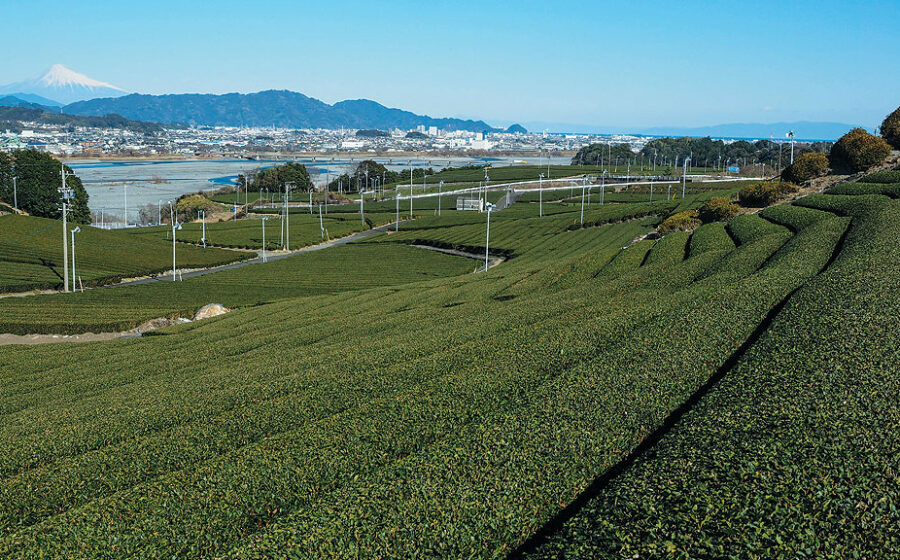[O]n March 8, 1854, Japanese residents living on the outskirts of Yokohama beheld an astonishing sight. Nine steam-powered naval vessels, each with 100 mounted guns, under the command of the United States Commodore Matthew Perry, stood at the entrance of their little harbor. President Millard Fillmore had directed his navy to open the ports of Japan to American trade—mainly for the benefit of New England whaling ships.
Fortunately, not a shot was fired before treaties were signed, and the hermit country of Japan began a headlong embrace of Yankee capitalism and culture. But within five years, whaling was in a sharp decline and sailors who once went to sea to battle the great leviathans of the Pacific were employed to man ships that carried an equally lucrative commodity: Japanese green tea.
As soon as Japan’s gates were pried open, the United States became its best tea customer. This was due to the direct transpacific shipping routes to Seattle and San Francisco, the Transcontinental Railroad, and America’s insatiable thirst for green tea. In 1859, 400,000 tons of Japanese teas were exported to the United States.
In 1860, American merchants were importing 10 percent of their tea from Japan. By 1870, the number had surged to 25 percent, and by 1880, Japanese green tea accounted for 47 percent of America’s tea imports while China supplied most of the balance. Per capita, each year Americans were consuming 1.3 pounds of tea and nearly eight pounds of coffee as the century came to a close.
Most of the tea loaded aboard ships at Yokohama originated just south of Tokyo in Shizuoka Prefecture where millions of tea bushes grow in the shadow of majestic Mount Fuji. Shizuoka tea gardens date back to 1241, when a monk named Shoichi Kokushi returned from Sung China with tea seeds, which he planted in his home prefecture. Tea growing became economically important here in the 1600s when Tokugawa Ieyasu, founder of the last shogunate and a devoted practitioner of chado, the green tea ceremony, began to cultivate tea in the Makinohara area.
On a sunny but blustery January afternoon, I met tea farmer Morihiko Yamamoto, a descendant of Tokugawa Yoshinobu, the last shogun, on the Horai Bridge, the longest wooden bridge in the world. We walked across the bridge to view the vast carpet of green tea fields that lie on the eastern side of the Oi River.
Row upon row of tea plants, managed by small- and large-plot growers, stretched as far as the eye could see. Makinohara, with Mount Fuji rising in the distance, is the largest producer of tea among the eight growing regions of Shizuoka Prefecture. This spectacular vista of perfectly manicured tea bushes is broken only by the intermittent placement of electric fans, perched on poles, that circulate the air on spring mornings when frost or cold dew can damage tender new leaves.
Yamamoto guided me through the fields to the base of a towering statue made in the image of his famous shogun ancestor. Reading from an English script, this twenty-first century Japanese tea grower recounted the story of tea’s genesis in this fertile river valley. Much of the tea found in nineteenth century American tea cups came from these fields. In those days, the leaves were plucked by hand and green tea was manufactured using the same firing, rolling, and sorting methods taught to Japanese tea growers by Chinese tea masters. Cheap labor was plentiful a century ago but today’s production methods are designed for maximum productivity and quality control. This modern efficiency begins before the tea leaves the field.
Over my head stretched hand-hewn beams that had witnessed countless sencha tea rituals over four centuries. If a house, too, can possess a sense of terroir, this humble home is uniquely rich indeed.
I watched one of Yamamoto’s workers maneuver a mechanical harvester as he gave the tea bushes one last light preening in preparation for the new flush of leaves that would appear in April. The crawler-tractor straddled the long rows and moved slowly over the plants as its sharp blades manicured the bushes and vacuumed the clippings into a hopper. This machine is kept in almost constant use during the peak harvest months of May through October. It replaces hundreds of human hands that once plucked leaves in these fields.
For over a century, the Japanese tea industry has led the world in mechanization. Considering land values and the high costs of labor, this is the only way Japanese manufacturers can compete in a global market. While there is a small but growing demand for handmade artisan teas, the quality and consistency of mechanically-made teas is no longer considered an inferior choice when it comes to selecting Japanese teas.
The manufacturing facility for both Yamamoto and many of his neighbors’ harvest is housed in a cooperative facility nearby. This state-of-the-art factory is filled with bins, conveyor belts, tumblers, and dryers that steam, roll, clean, and dry Shizuoka tea leaves into finished products. A facility this size in India or Sri Lanka would be operated by thirty-five to fifty people. But because of the high degree of engineering and computerization designed into Japan’s tea industry, this modern unit can be operated by as few as two people.
Of course, the best way to evaluate the workmanship involved in producing tea is to share a cup with the tea master. Yamamoto capped off my visit with an impromptu pot of sencha as we sat on a traditional straw mat on the floor of his home. Next came an extraordinary cup of his black tea. It’s always a treat to be served by the tea maker himself and this was a delicious and rare tea drinking experience.
[S]encha green tea makes up 75 percent of all tea consumed in Japan and it has been the leading green tea export since the early twentieth century. The two essential elements for sencha making are steam (for fixing) and fire (for roasting). The flavors and aromatics of sencha are to a large extent a result of these two processes, while another flavor influencer is the choice of cultivar. Of the fifty-five cultivars registered in Japan, just one, called yabukita, makes up 80 percent of the plants used for green tea production. This cultivar was developed in Shizuoka in 1954 and has been prominent in Japanese gardens ever since. Its dominance is due to its lively, brisk flavor, which appeals to contemporary tastes, and to its adaptability to various regional climates.
Japanese production during the second half of the nineteenth century mimicked that of its mentor—China. As the twentieth century brought even more demand for volume, Japanese producers began using steam rather than heat from a wok to “fix” their fresh tea leaves and halt oxidation. The amount of time involved in steaming also contributes to the taste of green tea. A general rule is: the deeper the steaming, the thicker the brewed tea will become. Quick steamed teas (twenty to forty seconds) tend to be much lighter in color when viewed in the cup.
Shizuoka is known for a unique style of deep-steamed tea called fukamushi, which is steamed eighty to 100 seconds. These extra seconds of steam cause tea leaves to break down, lose their usual shape, and become separated. Fukamushi teas appear slightly more broken than other green teas. When steeped, it results in a distinctively rich, cloudy, dark-green liquor with notes (to my mind) of asparagus, egg yolk, and umami.
[W]hile different cultivars and manufacturing techniques contribute greatly to the unique taste of Japanese teas, another important catalyst for taste development is terroir. Terroir is a term we borrow from our wine friends when discussing the tendency of an agricultural product to mimic the soil, altitude, climate, and environment where it grows. It helps make both Darjeeling tea and Sonoma County Russian River pinot noir wine unique. Some of Japan’s legendary teas come from high mountain gardens where traditional tea farming methods and rich terroir produce distinctive—and prize-winning—teas.
I traveled inland along the Oi River and up hairpin mountain roads—reminiscent of the road to Darjeeling—to the famed Kawane region in search of Tsuro Tsuchiya, one of the last true warriors of traditional style Shizuoka tea who still handpicks 30 percent of his annual production.
Tsuchiya’s grandfather planted tea bushes on this steep mountainside farm a century ago. Now in his sixties, Tsuchiya introduced me to some of those original tea bushes that continue to thrive in this fertile soil. He is one of a declining number of tea farmers who carry on traditional growing methods, including some hand plucking. Dedication to growing artisanal teas has paid off for this quiet farmer. Tsuchiya’s 400-year-old home is filled with a row of gold medals he has won at the World Green Tea Contest, hosted for sixty-nine years in Shizuoka Prefecture.
“Who are your customers?” I asked.
“The people I sell to are people with discriminating tastes, true tea connoisseurs who want fine tea,” he answered through an interpreter.
His national fame as a gold medal tea grower is a sense of pride for his neighbors, too, on this isolated mountaintop. I asked how he goes about preparing teas for entry into this prestigious competition.
“I have to have the help of all my neighbors, including town officials, when the early spring teas are ready for harvest,” he said. “As many as fifty volunteers don white gloves and gently pluck the leaves from my finest bushes.”
Tsuchiya showed me those prize-winning bushes, protected by bright-blue netting from harsh winter winds and foraging animals. Those plants are easy to spot because, with their unruly climbing leaders, they lack the perfectly coiffed appearance of his nearby mown tea fields.
After exploring his little tea kingdom, it was time for me to enter the Tsuchiya home for a tasting of high mountain sencha. We sat on straw mats in front of a brazier that provided a bit of heat and comforted us from the January cold. Behind me was the family’s Shinto shrine where offerings were made to guarantee a good crop of tea. Over my head stretched hand-hewn beams that had witnessed countless sencha tea rituals over four centuries. If a house, too, can possess a sense of terroir, this humble home is uniquely rich indeed.
Tsuchiya and I sipped multiple infusions from tiny, white, handleless cups. The liquor was pale canary yellow. Tea grown at high elevation sustains greater temperature variations than tea grown at sea level. This harsh terroir imparts a unique depth to the tea. His Kawane sencha also has a complex minerality derived from the rocky soil, a slight baked flower aroma, and plum-like finish.
I don’t speak Japanese and Tsuchiya spoke no English, so I couldn’t verbally tell him those flavor notes I was experiencing. Nonetheless, we were communicating through our eyes, our breath, our pauses, our head nods.
Okakura Kakuzo, author of the Book of Tea, would say we were experiencing “the cup of humanity.” This ancient beverage is the communal cup of the world which binds all teaists together in a fraternity that needs no words to communicate the language of the heart.
My search for good tea had given me yet another extraordinary experience. Teatimes over two days with Morihiko Yamamoto and Tsuro Tsuchiya awakened me to the exceptional qualities of Japanese teas and the passion of the tea masters who are fusing ancient traditions with modern technologies—all in the shadow of glorious Mount Fuji.
—Bruce Richardson is the owner of Elmwood Inn Fine Teas and author of the Great Tea Rooms of Britain and the New Tea Companion.













